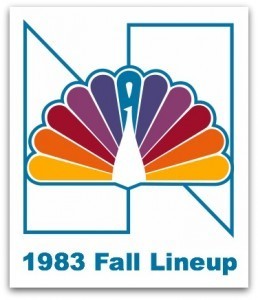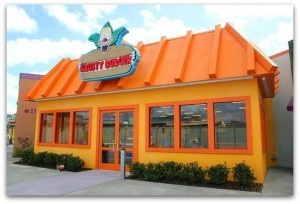Bathroom Readers' Institute's Blog, page 129
September 18, 2014
The Worst Fall Lineup in TV History
The new TV season begins this week, and the networks will roll out a few dozen new shows. A lot of them will be cancelled, but it still won’t be a programming bloodbath like NBC’s fall 1983 slate of new comedies and dramas.
 The Yellow Rose. CBS’s Dallas, a soap about a family of Texas oil barons was the #1 show on TV at the time. The Yellow Rose was NBC’s take. It was a soap opera about…a family of Texas oil barons.
The Yellow Rose. CBS’s Dallas, a soap about a family of Texas oil barons was the #1 show on TV at the time. The Yellow Rose was NBC’s take. It was a soap opera about…a family of Texas oil barons.
Mr. Smith. The titular character is a put-upon political advisor…as well as a chimpanzee made super-smart with an experimental chemical. It starred the orangutan from the popular movie Every Which Way But Loose.
Jennifer Slept Here. A typical American family moves into a new home in Los Angeles…that’s still inhabited by the ghost of the Old Hollywood movie star who once lived there.
Bay City Blues. Steven Bochco (Hill Street Blues, L.A. Law) created this show about the bittersweet lives of a constantly touring minor league baseball team.
We Got it Made. Much to the chagrin of their girlfriends, two New York roommates hire a sexy live-in maid.
Boone. A 1950s-set drama about a teenager named Boone Sawyer who wants to be a part of that newfangled “rock and roll music,” much to the chagrin of his conservative father.
The Rousters. The adventures of two modern-day bounty hunters who are descended from Western lawman Wyatt Earp.
For Love and Honor. A romantic drama set on a military base, clearly inspired by An Officer and a Gentleman.
Manimal. A handsome playboy helps police solve crimes…with his unique ability to transform into any animal he wishes. (Man + animal = “manimal.”)
What do these shows all have in common? Every single one of them was cancelled by the end of their first season. Never before, and never since, has one of the TV networks had a zero-hit rate of new fall shows.
The post The Worst Fall Lineup in TV History appeared first on .
ROBOTICA Invasion: A Self-Made Robot
We just released our latest book: ROBOTICA: Mechanical Marvels and Mind-Melting Machines of the Past, Present, and Future. Here’s a look at the kind of stories you’ll find in ROBOTICA! Introducing the first self-made robot.
 People who fear a robot uprising can be calmed down by the fact that 1) Robots aren’t yet advanced to the point where it’s even possible for them to achieve “self awareness” and hurt humans, and 2) Robots still have to be built by humans, and programmed by humans.
People who fear a robot uprising can be calmed down by the fact that 1) Robots aren’t yet advanced to the point where it’s even possible for them to achieve “self awareness” and hurt humans, and 2) Robots still have to be built by humans, and programmed by humans.
Never mind all that. A joint team of engineers from Harvard University and the Massachusetts Institute of Technology have created the world’s first ever robot that can assemble itself. According to the abstract of the article published in the August issue of Science, the team of super-geniuses took inspiration from origami, the 1,500-year-old art of paper folding. (Origami, like many robots, was created in Japan.) As origami involves folding a piece of paper—a flat surface—in such a way as to create a three-dimensional object. The engineers developed “shape-memory composites” with “embedded hinges”—in other words, thin flat sheets of paper-like material embedded with electronics (and attached to robotic components) with pre-folded lines.
The robot, following the programmers’ programming, was then able to fold themselves along those predetermined lines. The result: a robot that in just four minutes turned itself from paper and electronic stuff into a bug-like, crawling robot that moved on its own without any human interference.
All hail the robots? Click here to order ROBOTICA !
The post ROBOTICA Invasion: A Self-Made Robot appeared first on .
September 12, 2014
Fake-or-Fact Friday: Get In the (Nicolas) Cage
 Every Friday we give you a handful of weird stories and you have to determine which of them are true and which ones are made up. Why would we make them up? Because it’s fun! See if you can tell which are real ways the eccentric actor Nicolas Cage prepared for a role…and which ones are too strange even for him. (Answers at the end of the post.)
Every Friday we give you a handful of weird stories and you have to determine which of them are true and which ones are made up. Why would we make them up? Because it’s fun! See if you can tell which are real ways the eccentric actor Nicolas Cage prepared for a role…and which ones are too strange even for him. (Answers at the end of the post.)
A.
For his Oscar-winning role in Leaving Las Vegas as an alcoholic trying to drink himself to death, Cage would get incredibly drunk and then videotape himself talking. He then studied those videotapes to make sure he accurately repeated his own drunken speech patterns when the cameras rolled.
B.
In the 1998 movie City of Angels, Cage played an angel who helped protect Los Angeles, silently wandering the streets in a black trench coat. For a month before shooting began, Cage lived on the streets of L.A., rarely resting and walking around endlessly in a long, black trench coat while wearing angel wings underneath.
C.
Cage played the title character in the 2007 film Ghost Rider, a superhero who could communicate with ancient ghosts. Beforehand, Cage painted his face to resemble Caribbean folk religious figures, and bought authentic ancient Egyptian relics to trick his own mind into believing that he really could contact ghosts.
D.
In the 1984 film Birdy, Cage plays a man recovering from severe injuries suffered while fighting in the Vietnam War. His character had two missing teeth…so Cage had two of his own teeth removed, too. And he did it with no anesthetic, because that’s not how his character had his teeth knocked out.
Want more fake facts? Then check out Uncle John’s Fake Facts. (Really!)
The post Fake-or-Fact Friday: Get In the (Nicolas) Cage appeared first on .
September 11, 2014
3 Fictional Cafes That Became Real
Have you ever wanted to visit the places where some of your favorite characters have grabbed a bite to eat or once sliced off an alien’s arm with a lightsaber? Now you can!
Central Perk
 In the past, we’ve written about the two real establishments . Now New York City will soon have its own formerly fictional watering
In the past, we’ve written about the two real establishments . Now New York City will soon have its own formerly fictional watering
hole for fans of Friends. In honor of the 20th anniversary of the show’s premiere, Warner Bros. teamed up with Eight O’Clock Coffee to build a fully-functional Central Perk, just like the one where Rachel worked and the rest of the characters hung out. It’s scheduled to open on September 17th and will feature everything from the show’s iconic orange coach to musical performances by kooky singers similar to Phoebe Buffay (Lisa Kudrow). Alas, the coffeehouse will only be operating for a little over a month.
It’ll close forever on October 18th but, if you’re willing and able to fly overseas, the UK has two permanent Central Perks.
Krusty Burger
 Wanna sink your teeth into a Krusty Burger or a “Partially Gelatinated Non-Dairy Gum-Based Beverage”? Well, then head on down to Universal Studios Orlando. The theme park now offers “Springfield USA,” an area entirely devoted to The Simpsons. If they dare, visitors can dine at a real-life Krusty Burger stand. It’s located in a cafeteria-style eatery called The Simpsons Fast Food Blvd, which also includes recreations of Moe’s Tavern and a chicken joint inspired by Cletus, the show’s “slack-jawed yokel.”
Wanna sink your teeth into a Krusty Burger or a “Partially Gelatinated Non-Dairy Gum-Based Beverage”? Well, then head on down to Universal Studios Orlando. The theme park now offers “Springfield USA,” an area entirely devoted to The Simpsons. If they dare, visitors can dine at a real-life Krusty Burger stand. It’s located in a cafeteria-style eatery called The Simpsons Fast Food Blvd, which also includes recreations of Moe’s Tavern and a chicken joint inspired by Cletus, the show’s “slack-jawed yokel.”
The Mos Eisley Cantina
Rumors surround Disney’s plans to expand the number of Star Wars attractions in its theme parks. Some say the company’s “Imagineers” are currently hard at work on developing concepts and blueprints for an entire land in Disney World devoted to the films. Nothing will be official until sometime next year but fans are hoping they’ll add a café based on the Mos Eisley Cantina, the intergalactic dive bar where Luke Skywalker first met Han Solo and Chewbacca. In the meantime, they can see an animatronic version of the cantina’s band play at Rancho Obi-Wan, a Star Wars museum in northern California.
The post 3 Fictional Cafes That Became Real appeared first on .
Batman is Real, and He Lives in Japan
Does the Dark Knight really exist? Well, kinda …
 Since 2011, an unidentified gentleman has been buzzing around Japanese motorways on a custom made Batpod while dressed as a certain caped crusader. He’s known locally as “Chibatman” because he lives somewhere in Chiba Prefecture, the region where Tokyo and Hokkaido are located.
Since 2011, an unidentified gentleman has been buzzing around Japanese motorways on a custom made Batpod while dressed as a certain caped crusader. He’s known locally as “Chibatman” because he lives somewhere in Chiba Prefecture, the region where Tokyo and Hokkaido are located.
Not much is known about Chibatman’s secret identity other than that he’s 41 years old and he also works as a welder at a shipyard. His three-wheeled “Chibatpod” cost him around $5,700 US to construct and he had to import many of the parts from overseas.
Chibatman is reportedly single. However, just like Batman, he’s eager to keep his personal life totally private. Plus, a la the Gotham City PD, the local police force isn’t completely on board with this whole thing. They recently asked Chibatman to visit a nearby precinct for a little chat. Instead of asking him to knock it off, they just wanted to make sure that his Chibatpod met various vehicle regulations and that his cape was properly attached to his armor. The police were worried that it might fly off and hit another motorist’s windshield.
Unlike the Dark Knight, however, Chibatman doesn’t fight crime or homicidal clowns. Instead, he just wants to make people happy. During interviews and his encounters with the public, Chibatman speaks in a raspy voice much like the one actor Christian Bale used for the recent Batman trilogy. Between treks on his Chibatpod, he explained his ongoing mission to a camera crew from BBC News.
“I started doing this around three years ago,” he said. “As for my reasons, during the great [2011 Fukushima] earthquake, people forgot how to smile. I wanted to help bring the smile back and that’s why I started.”
The post Batman is Real, and He Lives in Japan appeared first on .
September 10, 2014
Flushing History Down the Toilet
The story of human civilization can be told through textbooks…or toilets.
 A recent exhibit in the central pavilion of Vienna’s Giardini della Biennale museum is using toilets to teach its visitors about the development of society through the ages. It’s all part of Venice’s 14th annual International Architecture Exhibition, which is titled “Fundamentals” and continues through November 23. Appropriately enough, an entire gallery has been set aside to show how toilets have played a pivotal, and very fundamental, role throughout history.
A recent exhibit in the central pavilion of Vienna’s Giardini della Biennale museum is using toilets to teach its visitors about the development of society through the ages. It’s all part of Venice’s 14th annual International Architecture Exhibition, which is titled “Fundamentals” and continues through November 23. Appropriately enough, an entire gallery has been set aside to show how toilets have played a pivotal, and very fundamental, role throughout history.
Visitors are presented with a series of displays that feature several historical commodes. They can learn about how toilets became more sophisticated as technology and civilization advanced from that era into the Middle Ages and beyond. Among them: a solid stone, and presumably very uncomfortable, potty from Ancient Rome, and a ceramic Austrian urinal built in 1895.
But the real fun is exploring some of history’s cruddiest commodes. Have you ever heard of a “valve closest”? If not, there’s a reason for that. While these toilets were popular among the wealthy in 19th century England, they were notoriously easy to break and their flushing systems were pretty worthless. They were eventually replaced with much more reliable models.
Along with information about everything from the development of bidets to how bathrooms have helped promote good hygiene, sanitation and the “livability” of cities, there’s also a few futuristic models like the Blue Diversion Toilet. It’s capable of cleaning and reusing water, which helped it win the top prize in Bill and Melinda Gate’s 2011 “Reinvent the Toilet” contest.
So why of all things are toilets featured so prominently in an architectural exhibition? Rem Koolhaas, the exhibit’s director, told the press, “No architectural treatise declares the toilet as the primordial element of architecture, but it might be the ultimate one.”
The post Flushing History Down the Toilet appeared first on .
Impossible Questions: Minnie Pig Edition (Answer)
Think you’ve got the answer? Keep reading to see if you nailed it.
What musical achievement links Minnie Mouse and Miss Piggy?
They are fictional anthropomorphic characters, of course…and both have performed a duet of “Don’t Go Breaking My Heart” with Elton John.
Between the gigantic glasses, elaborate stage shows, colorful music videos, and costumes that have included both Donald Duck and Louis XIV, Elton John is more or less a real life cartoon character. It should be no surprise then that the rock legend loves animation and kid stuff. He’s written and performed music for several animated movies, including The Lion King, The Road to El Dorado, and Gnomeo & Juliet. He’s also performed with animated characters, puppets, and fictional characters more often than most.
Here he is in 1988 on the NBC television special Totally Minnie, performing a duet of his 1976 hit “Don’t Go Breaking My Heart” with Minnie Mouse.
And here he is performing it back in 1978 on The Muppet Show with the only person at the time who was a bigger and more spectacular star than he was: Miss Piggy.
Need more impossible questions? Check out Uncle John’s Impossible Questions.
The post Impossible Questions: Minnie Pig Edition (Answer) appeared first on .
September 5, 2014
Jellies and Jams and Marmalades and Preserves and Butters and…
It’s almost time for the fall harvest here at BRI headquarters, and there is so much fruit around these parts that there’s only one way to keep it all: make it into jam! Or jelly. Or preserves. Or fruit butters. Now we’re confused. What’s the difference between all of those anyway?
 All of these ways to preserve fresh fruit for months on end to make it both sweeter and great on toast all involve very similar methods. To simplify the process, making a jam or jelly (or one of the others—please don’t make us lift them all every time) begins with boiling down fresh fruit until its incredibly soft, goopy, and saucelike, and adding sugar or another sweetener to make the taste more intense, but also as a preservative. Water is cooked out, which adds to the flavor intensity and increases shelf life. The addition of citric acid aids in tartness, and pectin is a jelling agent that makes jelly, well, jellylike.
All of these ways to preserve fresh fruit for months on end to make it both sweeter and great on toast all involve very similar methods. To simplify the process, making a jam or jelly (or one of the others—please don’t make us lift them all every time) begins with boiling down fresh fruit until its incredibly soft, goopy, and saucelike, and adding sugar or another sweetener to make the taste more intense, but also as a preservative. Water is cooked out, which adds to the flavor intensity and increases shelf life. The addition of citric acid aids in tartness, and pectin is a jelling agent that makes jelly, well, jellylike.
The starting point of the fruit, and subtle changes in texture of the end products, are what differentiate jams from jellies from butters from marmalades from preserves.
• Jellies are made from strained fruit juice and come out smooth.
• Jams are made from crushed fruit and are generally chunky and have little bits of fruit and seeds that remain intact.
• Preserves use whole fruit (if it’s a small fruit, like berries), or large, rough chunks of fruit.
• Marmalade is just a type of jam—it’s a name reserved for citrus fruits only, usually oranges, and the peel is thrown into the mix, too.
• Fruit butters (apple butter, rhubarb butter) are made from stewed fruit. The fruit is cooked for a long time, until the natural sugars in the fruit caramelize, which make the end product thick, like butter.
The post Jellies and Jams and Marmalades and Preserves and Butters and… appeared first on .
Fake-or-Fact Friday: Are These ‘60 Minutes’ Spinoffs Real or Not?
 Every Friday we give you three news stories and ask you to pick which two or true and which one was made up. This time, we’re doing it a little differently. Below are a bunch of spinoffs of CBS’s venerable news magazine 60 Minutes. Can you guess which ones aired and which ones are pure fiction? (Answer is at the bottom of the post.)
Every Friday we give you three news stories and ask you to pick which two or true and which one was made up. This time, we’re doing it a little differently. Below are a bunch of spinoffs of CBS’s venerable news magazine 60 Minutes. Can you guess which ones aired and which ones are pure fiction? (Answer is at the bottom of the post.)
A. 30 Minutes
In 1978, CBS introduced 30 Minutes to its Saturday morning cartoon lineup. Featuring none of the regular 60 Minutes cast (not even Andy Rooney), the show ran for four years with light news stories that would appeal to kids.
B. 120 Minutes
MTV’s long-running showcase of alternative rock music ran on the cable network from 1986 to 2003. But from 1984 to 1986, MTV ran another show called 120 Minutes—a two-hour long block of news oriented to people in their 20s. Produced by the news division corporate parent CBS, it was to fulfill an FCC “news and information” requirement in effect at the time. (In 1986, MTV established its own news bureau, MTV News, and re-used the name for the video show.)
C. 60 Minutes More
Comedies and dramas can be rerun frequently, but what about primetime news shows like 60 Minutes? Not so much, although CBS sort of tried to repackage old episodes of 60 Minutes. 60 Minutes More consisted of old 60 Minutes reports with newly filmed updates to those stories. It ran for just one season in 1996.
D. 60 Minutes: The Magazine
60 Minutes is a newsmagazine, using TV to recreate the format of a print news source, like Time or Newsweek. On its 25th anniversary in 1994, producers of 60 Minutes launched 60 Minutes: The Magazine…a print news magazine, based on the TV news magazine, which aped the format of print news magazines. Like the show, the magazine had 60 pages (of which a quarter was advertisements), reporting from Mike Wallace and Lesley Stahl, and a light-hearted editorial from Andy Rooney. (It folded in three months.)
E. 60 Minutes of Sports
A direct competitor to ESPN’s 30 for 30 series of hard-hitting sports documentaries and HBO’s similar Real Sports, Showtime debuted 60 Minutes of Sports in 2013. It’s a combination of brand new sports reporting and “classic” sports stories from old episodes of 60 Minutes.
Answer: “B. 120 Minutes” and “D. 60 Minutes: The Magazine” are the fakes.
Want more things that sound true…but aren’t? Then check out Uncle John’s Fake Facts. (Really!)
The post Fake-or-Fact Friday: Are These ‘60 Minutes’ Spinoffs Real or Not? appeared first on .
September 4, 2014
ROBOTICA Invasion: Cruising With the Booze Bots
We’ve got a new book coming out this month called ROBOTICA: Mechanical Marvels and Mind-Melting Machines of the Past, Present, and Future. Yep—it’s a book all about awesome robots. Here’s a little taste of the strange and wonderful robots you’ll find in that book.
 This November, the maiden voyage of the Quantum of the Seas will revolutionize the way that vacationers journey across the oceans. The 167,800-ton boat is one of the most technologically sophisticated cruise liners ever built. Along with a skydiving simulator and wristbands that enable passengers to unlock their rooms and make dinner reservation, the ship also features a sleek lounge with robotic bartenders.
This November, the maiden voyage of the Quantum of the Seas will revolutionize the way that vacationers journey across the oceans. The 167,800-ton boat is one of the most technologically sophisticated cruise liners ever built. Along with a skydiving simulator and wristbands that enable passengers to unlock their rooms and make dinner reservation, the ship also features a sleek lounge with robotic bartenders.
At the Bionic Bar, passengers place their orders via an electronic tablet, which beams their requests to one of the lounge’s metallic mixologists. Unfortunately, they’re not quite as sophisticated or chatty as the robotic bartenders like in The Fifth Element. The Bionic Bar’s bartenders consist of robotic arms like the ones found on assembly lines. Each one is capable of dispensing just the right amount of alcohol and can prepare drinks either stirred or on the rocks. They can also give them a splash of fresh juice from a slice of lime without making a huge mess.
The lounge and its bionic bartenders are the first of their kind to ever appear on a cruise ship. Meanwhile, researchers and entrepreneurs elsewhere are attempting to design a more perfect version. Last year, a small convention dubbed BarBot 2013.75 took over an event space in San Francisco and pitted several cybernetic suds-slingers against one another.
It could be another decade or so before you find a robot working the bar in your favorite watering hole, which should give us enough time to figure out how much to tip a robot bartender.
The post ROBOTICA Invasion: Cruising With the Booze Bots appeared first on .



